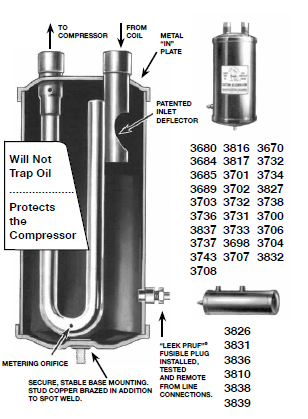What is a Suction Accumulator?

Suction Accumulators
A suction accumulator is used to prevent liquid refrigerant floodback to the compressor. A compressor is designed to move vapor refrigerant, NOT liquid, and the accumulator can really help us win that battle.
Accumulators are commonly used on heat pumps, transportation refrigeration systems, low-temp supermarket systems, and any place where liquid refrigerant flooding back to the compressor is likely.
The accumulator is installed in the suction line close to the compressor.
It usually is a vertical container with top connections. An internal U-tube reaching down near the bottom is installed on the accumulator outlet connection so that the inlet tube is near the top of the container. It allows the accumulator to be almost full before a floodback can occur if the accumulator is sized correctly.
A small hole is drilled in the U-tube near its lowest point. This hole allows a controlled meter of any liquid refrigerant or oil back to the compressor with a siphoning action. That hole is generally covered in a screen to keep the hole from plugging and preventing oil return. Accumulators need to be kept clean and free of debris, or that screen at the bottom of the U-bend can potentially block as well, which is why the accumulator should be emptied and flushed when a system has a significant burnout or another type of contamination event.
To work best, it is sometimes advisable to have a heat source on the vessel to assist in evaporating the liquid refrigerant. This may be an electric heat tape or pad. Some accumulators have connections so that a liquid line loop can be piped into the bottom of the accumulator. This improves the system's performance by subcooling the liquid refrigerant and protects the compressor against liquid slugging by providing additional superheat to the suction gas.
—Louie Molenda






